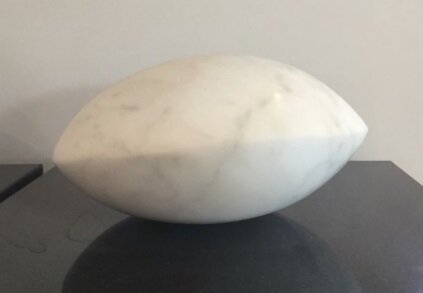Jerry Wingren
-
Jerry Wingrenwas raised in a small port town on an island in southeastern Alaska, whose population was split about evenly between Norwegian immigrants and Tlingit natives. As a child, he was surrounded by nature, by resource industries (fishing, canning, logging), and also by the native totem poles, whose influence on his work did not show up until much later.
-
Wingren entered the University of Washington in 1959 to study Scandinavian and German language and literature, and began spending a lot of time at the university art school. He was awarded a Fulbright scholarship to study German drama at the University of Bremen. Before he left he began carving an abstract eye out of a piece of timber, and admitted to a friend that he didn't want to write a dissertation, but instead wanted "to carve and carve and carve."
In Bremen he befriended two master sculptors, Otto Almstadt and Moritz Bohrmann, and began an apprenticeship in stone sculpture with them. For two years he worked in sculptural "actions" with the group Kontakt Kunst, who "performed" live sculpting all over Germany.
In Heidelberg, Wingren studied Origami with Hiromi Hoshiko. On his return to the United States, he began creating large three-dimensional works in steel--influenced by Origami's method of turning a two-dimensional plane into three dimensions by folding. He worked in aluminum and faceted marble, investigating mathematical equations and the I Ching. He was inspired by the mathematics in nature, creating apertures in blocks of granite and marble that allow light to pass through on the solstice or equinox, days of special importance in northern regions.
In the mid-eighties, Wingren represented the United States at the International Stone Sculptors Symposium in Bremen, and made his first visit to the renowned black granite quarries in Sweden, near the native village of his ancestors. He has since spent part of every year making sculptures there.
In the late eighties, he began making totems, accentuating the beauty of cedar in abstract forms. A sabbatical trip to Japan in 1996 introduced him to Zen gardens, leading him to "downsize," creating small totems and his "Little Houses" made of steatite.
In recent years, Wingren has continued to incorporate elements of his northwest and Scandinavian heritage with Japanese aesthetics. He has exhibited widely in the U.S. and Europe in private galleries and art museums, including the Atlanta Sculptural Arts Museum, the Denver Art Museum, and the Kleine Orangerie in Berlin. His works are found in private and public collections in the U.S., Germany, Norway, Sweden, Italy, Spain, and Japan.
-
House Guests 2019/2020 | House Guests 2017 | Paramnesia
Swedish Black Granite Resting Stone #8, 7"x16"x14"
Small Marble Resting Stone #1, Colorado White Marble, 4"x 7.5"x7.75"
Swedish Black Granite Resting Stone #33, 7"x 16"x 14"




